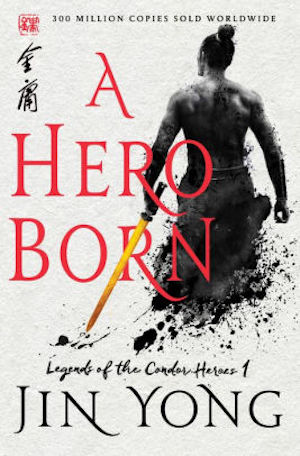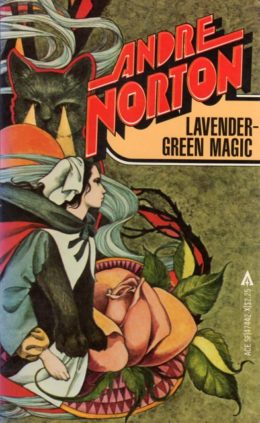Of all the Magic books, this is the one I thought I remembered the best. It turns out all I remembered was the folk ditty that inspired the title, and a few small bits about witchcraft. Everything else read as completely new.
Maybe the book I remember was another one built around “Lavender’s blue, dilly-dilly.” Maybe memory is just being weird. Either way, I did enjoy this, though with some fairly large doses of “Ummm… no.”
Lavender-Green Magic was first published in 1974, but at one point we learn that the story is set in 1970. It has a flavor of the late Sixties, with the dad missing in Viet Nam, the mom scraping out a job at a nursing home so isolated no one wants to work there (I find myself wishing that story had been written, though probably not by Norton, and probably as a horror novel, but I digress), and the kids dropped off with their grandparents. The way they ride around in the back of an old pickup truck is so not 2019—a nice lady author would never dare have kids do that now, with all the safety regulations that have accreted in the past fifty years.
What I had not remembered at all was that the family is Black, and living in Massachusetts, close enough to Salem that the witch trials are an ongoing undertone in the story. The protagonist, Holly, is keenly aware of her racial identity, so much so that she actively repels attempts by the white kids at her new school to make friends. She’s also all too aware of class and economic status: Her grandparents’ lives in the middle of the town dump are an ongoing source of shame and resentment.
Her twin siblings, Judy and Crock (short for Crockett), are a year younger and much less resistant to fitting into their new home. Crock is quite mature and quite socially adept. Judy acts and talks like a much younger child, but she also makes friends easily. As the story progresses, she becomes less and less willing to let Holly order her around. She plays the Lucy role in this portal fantasy.
Holly is a complicated character. Norton’s forte is not characterization, but with Holly she manages both depth and nuance. Some aspects are not totally comfortable in 2019—Holly presents as an Angry Black Girl, and the message is that she should be less angry and more willing to realize that it’s all in her head; really, white people just want to be nice. That from the standpoint of 2019 is… ummm, no.
Racial and ethnic diversity is a theme of the Magic books, and it’s clear Norton did a lot of thinking about it. She cared. But here she puts the burden of acceptance on the minority character, relaying a message of “let’s stop dredging up all that old bad history and just get along.” This plays better in Octagon Magic, where a white kid confronts racism from that side of the divide. The theme is the same, but the emotional burden is shifted in a more contemporary direction.
Still, much of what Holly is and does rings true to me for the period and the age group. She’s in sixth grade, just on the edge of adolescence, and her whole world has been turned upside down.
Holly has a strong sense of how the world ought to be, and a strong resistance to change. She acts out rather badly, nearly succumbs to the powers of evil, and has to be saved by her younger, more adaptable siblings. It’s a less abrupt transformation than Norton’s usual, and a more realistic portrayal of the emotional storms of the almost-teenager. I was a lot like that, bad parts and all. I can relate to her.
The adventure itself, traveling in time through a three-hundred-year-old garden maze, has much in it for me to love. There’s herb magic and witchcraft both good and evil. There’s a carefully crafted historical setting with deliberate parallels to the witch trials in Salem. It all ties in through the maze, the family that owns the land, and the twofold problem the kids have to solve: the attack on the so-called witch in the seventeenth century, and the selling off of the land to developers in the twentieth.
The latter is similar to the situations in Octagon Magic and Dragon Magic, with an even more directly personal element, in that the grandparents will be homeless if the land is sold. Holly learns (albeit kicking and screaming) to care about this, and ultimately plays a key role in resolving it.
There’s a lot I love about this book, and one thing, racial politics aside, that truly set my teeth on edge—even after I figured out what it was actually doing. That’s the dialect that almost all the adult characters speak. The grandparents talk like Uncle Remus and the white townsfolk like the good souls of Sixties television Westerns. As for the seventeenth-century characters, their speech is thick with thees and thous and weird archaic syntax. It’s trying so hard for verisimilitude that it defeats itself.
Buy the Book


A Hero Born
Then it dawned on me. The kids are speaking regular English, as is their mom. Everybody else is essentially speaking a foreign language. It’s the same mechanism as the comic strip Peanuts, which was hugely popular in the Seventies. The kids there spoke standard English, but the adults, on the rare occasions when they showed up at all, spoke gibberish. For the television cartoons, there’s even a sound generator for the teacher’s voice.
So here we get broad and regionally inaccurate dialect for nearly all of the 1970 adults, and broad and nearly incomprehensible dialect for the 1600s. The only really clear voices are those of the kids. Which is really rather clever.
Speeches aside, there’s so much here that’s worth reading, now as well as then. History is real and literal and immediate, libraries and research are places to actively seek out, and librarians and archivists are allies of even the most disaffected kid. The events of three hundred years ago have direct and important consequences in the present day. The story sheds a whole new light on the value of primary sources.
What’s particularly fun is to see the little bits of tribute Norton pays to her adult works (and, tangentially, the science-fiction genre). There’s a hint of the psi/esper powers of her Forerunner universe, a nod to that beloved science-fiction trope, the robot, and echoes of the Witch World in both aspects of the maze, particularly the monsters of the left-hand path.
Norton has moved away from the Fifties nightmare of atomic holocaust, but there’s still a glimmer of her starfaring future. Then again, the Forerunners go back into the remote past; who knows what they might have left on this planet, which our time-traveling kids and their seventeenth-century friends and enemies could not have been aware of.
I’ll be reading Red Hart Magic next time, to complete the series. I don’t recall having read it when it was first published, but I may have, somewhere in my library-prowling.
Judith Tarr’s first novel, The Isle of Glass, appeared in 1985. Her most recent novel, Dragons in the Earth, a contemporary fantasy set in Arizona, was published by Book View Cafe. In between, she’s written historicals and historical fantasies and epic fantasies and space operas, some of which have been published as ebooks from Book View Café. She has won the Crawford Award, and been a finalist for the World Fantasy Award and the Locus Award. She lives in Arizona with an assortment of cats, a blue-eyed dog, and a herd of Lipizzan horses.










